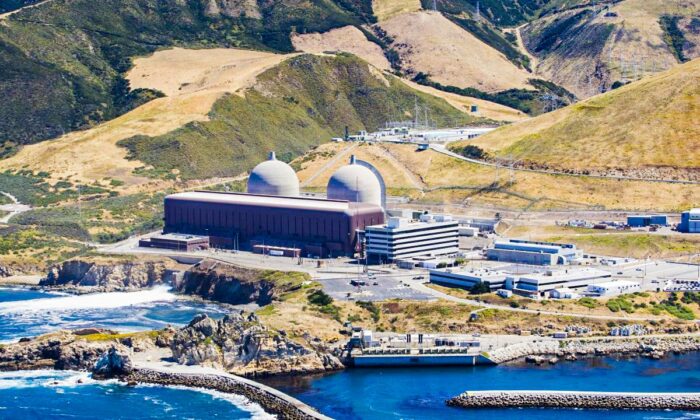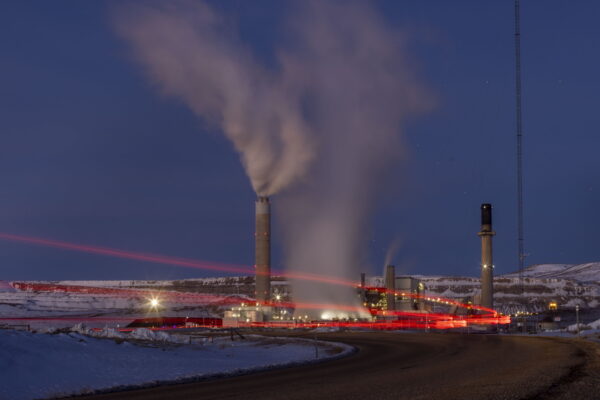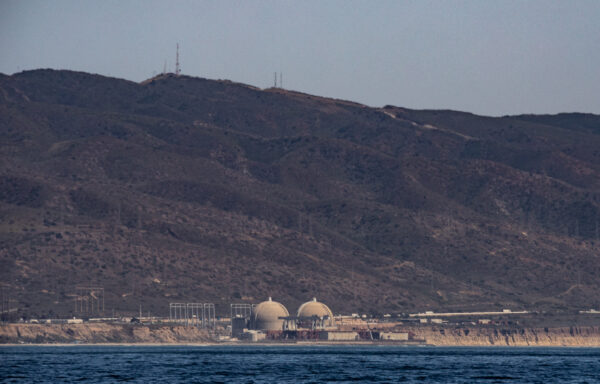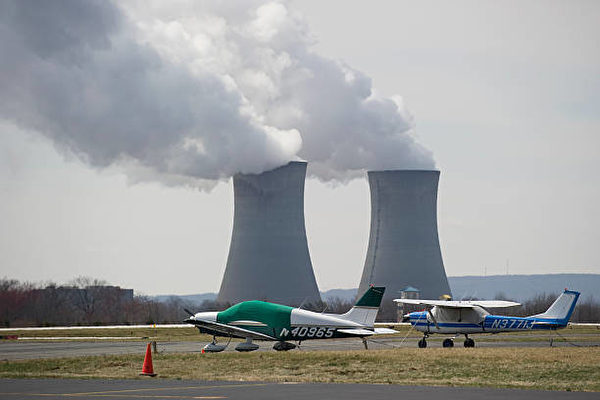
The Diablo Canyon Nuclear Power Plant, in Avila Beach, Calif., is among
the nation's 55 operating nuclear power plants. (Joe Johnston/The
Tribune (of San Luis Obispo) via AP)
Uranium mining in the United States hasn’t been profitable since the Russians flooded the global market with predatorily priced ore and processed fuel a decade ago.
Long before, the nation’s atrophied uranium enrichment industry, episodically idled by market paralyses and perpetually frozen in costly multi-jurisdictional regulatory entanglements, had ossified into obsolesce.
In 1980, the United States produced and processed 90 percent of the uranium used by 251 nuclear power plants that generated 11 percent of the country’s electricity.
In 2021, only 5 percent of the uranium used by the 55 nuclear power plants operating in the United States—which now generate 20 percent of the nation’s electricity—was produced domestically.
After years of Russian market manipulation stymied profitable domestic production, Congress has responded since 2020 with a series of bills that could, if approved, collectively spend up to $5 billion by 2035 in an attempt to seed a domestic commercial uranium market back to life.
Despite slow-rolling allocations and delays in launching programs, which some attribute to resistance within the Biden administration to nuclear power, mines across five states—mostly in Texas and Wyoming currently permitted to excavate uranium—will soon begin doing so.
Others elsewhere are also expected to participate in the U.S. Department of Energy (DOE) uranium consortium and subsidized market incubator.
Texas has the most uranium mining operations, but Wyoming has the most uranium, Wyoming Mining Association Executive (WMA) Director Travis Deti said.
“For all purposes,” he declared, “the state of Wyoming is the American uranium industry.”
There are four permitted uranium mines in the Cowboy State and at least three other prospective operations in regulatory review, Deti told The Epoch Times.
They’re ready to start digging this spring. “We can mine all the uranium we need in the U.S. right here in Wyoming,” he said.

US Enrichment Capacity: One Mine
But unfortunately, there’s nowhere in the United States for Wyoming mines to send ore for enrichment. Nationwide, only one plant in New Mexico has the capacity to enrich uranium for use in commercial nuclear reactors.
“Even if we were mining it now, we’re shipping it somewhere else [overseas] to get it enriched and refined,” Deti said. “When it comes to conversion and enrichment, we have no capacity to do that” in the United States.
Deti told The Epoch Times he has a solution for private industry: build enrichment plants in Wyoming near the mines, where there is a knowledgeable workforce and “friendly” state regulatory policies geared to spearhead the mine-to-market uranium recovery.
Deti also offers a solution for the Biden administration: to decarbonize energy and ensure a secure domestic energy supply, stop “paying lip service” to nuclear power as pivotal and de-zombify the nation’s uranium production industry by accelerating and streamlining permitting for ore excavation and processing.
“Right now, Russia has a hold on conversion,” or processing uranium for commercial use, he said. Russia produces more than 50 percent of fuel used for nuclear power across the world and nearly a quarter used in the United States.
“Getting everybody to recognize the problem” is a significant achievement, Deti said. But he’s concerned addressing the supply-chain gap won’t get the funding and regulatory relief it needs from the Biden administration, despite mounting bipartisan Congressional support for accelerating long-term remedies.
“I’m skeptical but hopeful,” he said. “We’re starting to turn in the right direction. It is possible that we can do it, but it is a heavy lift.”

Hot For HALEU
Bipartisan Congressional support for increasing domestic nuclear power generation is reflected in a $75 million allocation to establish a strategic uranium reserve in the Energy Act of 2020, a $6 billion fund to finance reactor upgrades in the Bipartisan Infrastructure Act, and $700 million in the Inflation Reduction Act to scratch-start a supply chain to seed and feed a domestic market for high-assay low-enriched uranium (HALEU).
The urgency in doing so precedes the February 2022 Russian invasion of Ukraine and is welcomed by the WMA along with the Uranium Producers of America, Nuclear Energy Institute, United Coalition for Advanced Nuclear Power, and U.S. Nuclear Infrastructure Council, among others.
In December 2020, the DEO also opened a HALEU consortium to “any U.S. entity, association, and government organization involved in the nuclear fuel cycle.”
HALEU is the required fuel for use in innovations such as small modular reactors (SMRs), which could revolutionize the delivery of nuclear generated power with relatively inexpensive, transportable reactors. SMRs are the focus of a $2 billion DOE program featuring 10 demonstration projects.
HALEU will be the nuclear fuel most in demand in coming years but, right now, there is no capacity in the United States to make it—not even for nine of the 10 DOE demonstration projects designed to use it.
The proposed Nuclear Fuel Security Act (NFSA), co-filed by Senate Energy & Natural Resources Committee Chair Sen. Joe Manchin (D-WV) and Sen. John Barrasso (R-Wyo.), accelerates domestic HALEU refining and enriching by $3.5 billion over the next 10 years.

Enough ‘Lip Service’
Deti and others say since it took more than two years to disperse the $775 million allocated for uranium development since 2020, it is uncertain if the Biden administration is capable of dispensing between $4 and $5 billon that could be soon approved in Congress with the alacrity needed to resolve the looming disconnect between wishful thinking and bottlenecked supplies.
In this case, ramping up demand for nuclear energy before a dead industry can be revived could make the United States even more reliant on imported processed Russian ore than it is now—especially as HALEU, which is now only commercially produced in Russia, sustains SMR innovation.
Deti said the Biden administration must further accelerate enrichment capacity development timelines and not resist efforts to streamline a federal permitting process that currently take at least a decade to approve for a mine.
“The Biden administration is all in on wind and solar but just giving lip service to nuclear,” Deti said, claiming that with the administration’s push to generate up to 40 percent of nation’s power with wind and solar sources, often available only 40 percent of the time, “we are seeing the destabilization of power grids because of the massive deployment of wind and solar,” which are “unreliable and expensive.”
“What is happening with nuclear more broadly is very exciting,” Uranium Producers of America (UPA) President Scott Melbye said before he, too, cited foot-dragging and regulatory reluctance regarding nuclear power by the Biden administration as obstacles in reviving the industry.
“The failed transition, globally, to clean energy has really highlighted how nuclear power is carbon-free, reliable, 24/seven baseboard energy,” Melbye told The Epoch Times.
“Energy policy is not virtue signaling like banning plastic utensils and plastic straws,” he added. “We got to get it right. Clean energy as an objective is fine, but the industry prefers doing it with more math and science, and less ideology.”
“We can’t do it on wind and solar alone,” Deti said. “We need a nationwide thrust to build nuclear capabilities and capacities.”
In February, House Energy & Commerce Committee Chair Rep. Cathy McMorris Rodgers (R-Wash.), filed HR 1042, the Prohibiting Russian Uranium Imports Act, which would ban the import of Russian ore within 90 days of adoption.
The WMA would “love to see” a Russian uranium import ban imposed, as would most involved in the U.S. uranium and nuclear industries, Deti said.
But, he said, there’s “a little caveat” with support for a Russian ore—before doing so, the United States must build a domestic supply chain to replace it.
“If a ban would actually take place,” Deti said, “it would put nuclear utilities in a tough spot.”
No comments:
Post a Comment